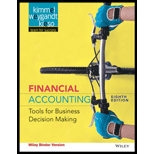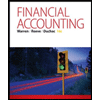
(a)
Statement of
Statement of cash flow is a financial statement that shows the cash and cash equivalents of a company for a particular period of time. It shows the net changes in cash, by reporting the sources and uses of cash as a result of operating, investing, and financing activities of a company.
Cash flows from operating activities: These refer to the cash received or cash paid in day-to-day operating activities of a company.
Direct method: This method uses the basis of cash for preparing the cash flows of statement.
Cash flows from operating activities: In this direct method, cash flow from operating activities is computed by using all cash receipts and cash payments during the year.
- A. Cash Receipts: It encompasses all the cash receipts from sale of goods and on account receivable.
- B. Cash Payments: It encompasses all the cash payments that are made to suppliers of goods and all expenses that are paid.
Cash flow from investing activities: This section of cash flows statement provides information concerning about the purchase and sale of capital assets by the company.
- Deduct the amount of cash used to purchase any fixed assets.
- Add the amount of cash received from sale of any fixed asset.
Cash flow from financing activities: This section of cash flows statement provides information about the
- Add the amount of cash received from any sources of finance.
- Deduct the amount of cash used for payment for dividend and interest from financing activities.
- Deduct the amount of cash used for payment of
treasury stock from financing activities.
To Prepare: Statement of cash flows of W Company using Direct method.
(a)
Answer to Problem 12.8AP
Prepare the statement of cash flows under direct method as follows:
| W Company | ||
| Statement of Cash Flows– Direct Method | ||
| For the year ended December 31, 2017 | ||
| Particulars | Amount ($) | Amount ($) |
| Cash flows from operating activities: | ||
| Cash receipts from customers (1) | ||
| Less: Payments to suppliers (2) | 179,000 | |
| Payment for operating expense (3) | 6,500 | |
| Payment for income taxes (4) | 9000 | |
| Payment for interest expense | 3,000 | |
| Total Payments made | (197,500) | |
| Net cash provided by operating activities | $38,500 | |
| Cash flows from investing activities: | ||
| Sale of equipment | 8,500 | |
| Net cash provided by investing activities | 8,500 | |
| Cash flows from financing activities: | ||
| Issuance of common stock | 4,000 | |
| Redemption of bonds payable | (16,000) | |
| Cash dividends payment | (20,000) | |
| Net cash used for financing activities | (32,000) | |
| Net increase (decrease) in cash | 15,000 | |
| Cash balance, December 31, 2016 | 20,000 | |
| Cash balance, December 31, 2017 | $35,000 | |
Table (1)
Working notes:
Calculate the cash received from customers as follows:
Calculate the amount of cash paid to suppliers as follows:
Calculate cash payment for operating expenses as follows:
Calculate cash payment for income taxes as follows:
The schedule of changes in liabilities is prepared as below:
| Schedule of change in assets and liabilities | |||
| Account Titles | Amount ($) | ||
| 2017 | 2016 |
Increase / (Decrease) | |
| Common stock | 18,000 | 14,000 | 4,000 |
| Bonds payable | 33,000 | 17,000 | (16,000). |
Explanation of Solution
The net cash provided by operating activities is calculated by deducting all cash payments incurred in the operating of the business from all cash receipts from the operating activities of the business. Here, cash receipt includes cash receipts from customers. Cash payments include all cash payments made to suppliers and operating activities.
Cash flow from investing activities is calculated by accounting for inflows and outflows of changes in investments and long terms assets.
Cash flow from financing activities is calculated by accounting for inflows and outflows of changes in long term liabilities and shareholders’ equity items.
Hence, Net increase in cash balance during the period is $15,000.
(b)
To Compute: free cash flow of W Company.
(b)
Answer to Problem 12.8AP
The free cash flow is calculated as follows:
| Particulars | Amount ($) |
| Net cash provided by operating activities | 38,500 |
| Less: Net cash used by investing activity | 0 |
| Less: Net cash under financing activity | 20,000 |
| Free cash flow | $18,500 |
Table (2)
Explanation of Solution
The free cash flow is computed by deducting capital expenditures (Investing activities) and dividends paid (Financing activities) from net cash provided by operating activities.
The free cash flow of W Corporation is $18,500.
Want to see more full solutions like this?
Chapter 12 Solutions
Financial Accounting 8th Edition
- Internal control refers to the processes and procedures implemented by an organization to ensure the integrity of financial and accounting information, promote accountability, and prevent fraud. These controls are designed to provide reasonable assurance that the organization achieves its objectives in operational efficiency, financial reporting reliability, and compliance with laws and regulations. Internal control is a comprehensive system that includes a variety of checks and balances, such as segregation of duties, authorization and approval processes, reconciliations, and physical security measures. It is an integral part of an organization's governance framework, helping to safeguard assets, improve operational efficiency, and ensure accurate and timely financial reporting. Respond to the above postarrow_forwardI need the correct answer to this general accounting problem using the standard accounting approach.arrow_forwardYou are a team of accounting consultants hired by the company VinGrenDom Ltd., a regional utility and manufacturing firm expanding into the Eastern Caribbean. The Board of Directors is requesting an accounting report that addresses three critical areas in their financial statements. Part A: Working Capital 1. Define working capital and explain its importance in financial health and liquidity management. 2. Assess how the matching concept and accrual basis affect the reporting of current assets and liabilities. 3. Using a hypothetical balance sheet (you may create one), identify at least 5 current assets and 5 current liabilities and analyze how changes in these elements affect liquidity ratios. 4. Recommend at least two strategies VinGrenDom Ltd. can implement to optimize working capital.arrow_forward
- Principles of Accounting Volume 1AccountingISBN:9781947172685Author:OpenStaxPublisher:OpenStax College
 Financial AccountingAccountingISBN:9781337272124Author:Carl Warren, James M. Reeve, Jonathan DuchacPublisher:Cengage Learning
Financial AccountingAccountingISBN:9781337272124Author:Carl Warren, James M. Reeve, Jonathan DuchacPublisher:Cengage Learning Financial AccountingAccountingISBN:9781305088436Author:Carl Warren, Jim Reeve, Jonathan DuchacPublisher:Cengage Learning
Financial AccountingAccountingISBN:9781305088436Author:Carl Warren, Jim Reeve, Jonathan DuchacPublisher:Cengage Learning  Financial Accounting: The Impact on Decision Make...AccountingISBN:9781305654174Author:Gary A. Porter, Curtis L. NortonPublisher:Cengage Learning
Financial Accounting: The Impact on Decision Make...AccountingISBN:9781305654174Author:Gary A. Porter, Curtis L. NortonPublisher:Cengage Learning Cornerstones of Financial AccountingAccountingISBN:9781337690881Author:Jay Rich, Jeff JonesPublisher:Cengage Learning
Cornerstones of Financial AccountingAccountingISBN:9781337690881Author:Jay Rich, Jeff JonesPublisher:Cengage Learning Managerial AccountingAccountingISBN:9781337912020Author:Carl Warren, Ph.d. Cma William B. TaylerPublisher:South-Western College Pub
Managerial AccountingAccountingISBN:9781337912020Author:Carl Warren, Ph.d. Cma William B. TaylerPublisher:South-Western College Pub





